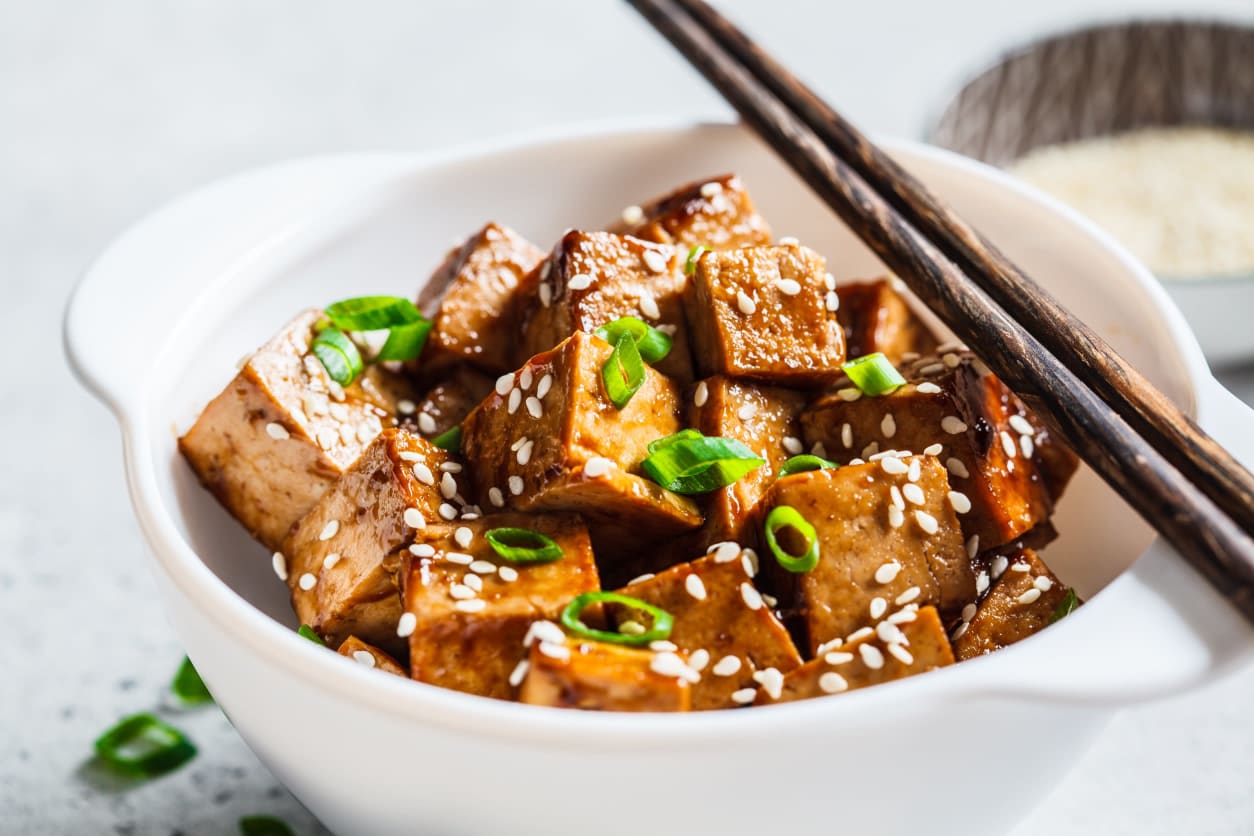Tofu is delicious when cooked right, but easy to get wrong.
My own first impression of tofu was less than pleasant. Served soggy and bathed in mushroom gravy, it made me think of soft meat gristle.
But I have since discovered that tofu is what you make it.
With a neutral flavour, tofu can be used in savoury or sweet foods, absorbing sauces, herbs and spices like a sponge.
It also comes in a wide range of textures which, depending on what you use it for, should be treated differently.
All of that does make for a sizeable margin of error, but tofu can be amazing as long as you know what you’re doing.
It’s also a great choice for those trying to cut down on animal products without losing out on protein and minerals.
What is tofu?
Sometimes referred to as ‘bean curd’, tofu is made by coagulating soya milk (made from soya beans) and pressing the resulting curds into solid white blocks that are then stored in water.
Soya beans, water and a curdling agent: that’s all it is.
Texture depends on how much water is pressed out. Silken tofu is like a firm yoghurt, whereas extra firm tofu has been pressed until almost crumbly.
Tofu is a totally plant-based complete protein (i.e. it contains all essential amino acids); for every 100g of firm tofu, you get nearly 20g of protein.
Iron, phosphorus, magnesium and zinc are also found in tofu, as well as calcium — depending on which curdling agent has been used.
Because it is a soya-based protein, tofu also contains isoflavones. These plant compounds are associated with a range of health benefits, from antioxidant and anti-inflammatory properties, to lowering cholesterol, decreasing blood glucose levels, and lowering heart disease risk.
Silken or firm tofu?
Pitfall number one, however, is picking your tofu. This is important; try to make a grilled vegan steak out of silken tofu and you’ll end up with a gloopy mess.
When following a recipe, pay close attention to what type of tofu is recommended.
But as a general rule of thumb, you will need firm or extra firm tofu to make solid blocks, and silken tofu when you want something creamy.
For tofu novices, extra firm can be a good place to start because it takes less prep too.

How to prepare tofu
To get the best out of firm (rather than extra firm) tofu, be prepared to do some pressing.
Because it’s immersed in water when you buy it, tofu often comes soggier than you want it, so you may need to press out that excess moisture.
In the absence of a tofu press – which can be a great little investment for anyone who plans on eating tofu regularly – this is an opportunity to get creative with kitchen roll, tea towels, a mixing bowl, a chopping board and tins from the cupboard.
Wrap the tofu in the kitchen roll and/or tea towels, pop it in a bowl, and build a weighty tower to squeeze that water out.
The heavier the weights and the longer you leave it, the more liquid will be removed, but as a general rule leaving it under pressure for about half an hour should do the trick.
Alternatively, if it’s extra firm tofu in only a little liquid, just give it a squeeze.
What to do with tofu
Here are some simple tofu recipes to give a try (with firm or extra firm tofu):
- For chewy bites with an umami punch, oven bake little tofu blocks drizzled in sticky teriyaki sauce and sprinkled with sesame seeds. Serve with rice and veg.
- Coat small cubes in cornflour with tarragon, salt and pepper, and fry in butter for crispy-on-the-outside, soft-on-the-inside herby goodness – great for salads or wraps.
- Grill a thin, slab-like tofu steak, seasoned with paprika, rosemary, salt and an optional drizzle of brown sauce – pair with chips and coleslaw.
- Marinate strips overnight, perhaps with soy or miso sauce, ginger, chilli and spring onions, to make plump pieces bursting with flavour. Add to stir fries, noodles and poke bowls.
- Crumble firm tofu into a mince and cook it with onions, chopped tomatoes, basil and a teaspoon of yeast extract such as Marmite (for umami) for tofu Bolognese – and serve with your pasta of choice!
What is tempeh?
If you fall in love with tofu and want a little more adventure, why not try tempeh? An Indonesian staple, tempeh could be described as tofu’s less famous cousin.
Made from whole, fermented soya beans rather than soya milk curds, it’s less processed than tofu and more textured.
Even better, tempeh boasts at least the same nutritional benefits as tofu – but more than double the protein and six times the fibre content.
Enjoyed this article?
Learn about the surprising properties of berries
For articles and recipes subscribe to Optimum Nutrition
Discover our courses in nutrition






